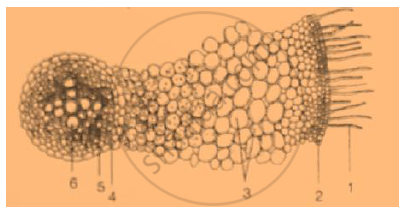Advertisements
Advertisements
Question
Choose the correct answer:
Which tissue makes passage for ascent of sap?
Options
Cortex
Endodermis
Phloem
Xylem
Solution
Xylem
APPEARS IN
RELATED QUESTIONS
The diagram of an given below demonstrates a particular process in plants. Study the same and answer the questions that follow :

(i) Name the apparatus.
(ii) Which phenomenon is demonstrated by this apparatus?
(iii) Explain the phenomenon mentioned in (ii) above.
(iv) State two limitations of using this apparatus.
(v) What is the importance of the air bubble in the experiment?
(vi) Name the structures in a plant through which the above process takes place.
Mention whether the following statement is true or false. Correct the false statement by altering the last word only.
Xylem is the water conducting tissue in plants.
Given below is the diagrammatic representation of the transverse section of a part of a plant. Study it and answer the questions that follow:

(a) Name the part of the plant that is shown
(b) Label the parts 1 to 6
(c) Write the functions of parts 3 and 5
Choose the correct answer:
Process of ascent of sap in plants occurs ___________
What is toxicity ?
Draw a cross-section of root showing association of soil particles with root hairs.
The figure given below is a diagrammatic representation of a part of the cross-section of the root in the root hair zone. Study the same and then answer the questions that follow :
(i) Name the parts indicated by guidelines ‘1’ to ‘5’
(ii) Is the root hair cell unicellular or multi-cellular?
(iii) Draw a labeled diagram of the root hair cell as it would appear if some fertilizer is added to the soil close to it.
(iv) Name the process responsible for the entry of water molecules from the soil into A1 and then A2.
(v) What pressure is responsible for the movement of water in the direction indicated by arrows?
(vi) How is this pressure set up?
Trace the pathway followed by water molecules from the time it enters a plant root to the time it escapes into the atmosphere from a leaf.
In soil which of the following type of water is available for absorption by plant roots?
